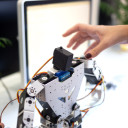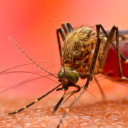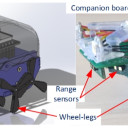
Engineering
12 Mar 2024
Beer byproduct behind Marmite could help us recycle metal waste
Scientists use spent brewer’s yeast, left over from manufacturing beer, to filter out metal from waste streams.

Engineering
12 Mar 2024
Scientists use spent brewer’s yeast, left over from manufacturing beer, to filter out metal from waste streams.

Engineering
29 Jan 2024
People who speak the Berlin dialect trust social robots speaking the same dialect more than social robots speaking standard German.

Engineering
30 Nov 2023
Researchers tested the suitability of a mix of rice husks and cellulose – materials commonly sent to landfills or garbage incineration plants – and found it had good thermal and mechanical properties, making it suitable to be used in a range of applications.

Engineering
03 Nov 2023
by Angharad Brewer Gillham, Frontiers science writer Image/Shutterstock.com Losing your sense of where you are can be fatal enough for aircraft pilots: spatial disorientation is a leading cause of fatal aircraft accidents. But losing your orientation in space itself is even more dangerous. Scientists have now developed wearable devices called vibrotactors that, combined with specialized training, improve people’s ability to fight spatial disorientation and could help astronauts correct themselves when their perceptions can no longer be relied upon. The sky is no longer the limit — but taking flight is dangerous. In leaving the Earth’s surface, we lose many of the cues we need to orient ourselves, and that spatial disorientation can be deadly. Astronauts normally need intensive training to protect against it. But scientists have now found that wearable devices which vibrate to give orientation cues may boost the efficacy of this training significantly, making spaceflight slightly safer. “Long duration spaceflight will cause many physiological and psychological stressors which will make astronauts very susceptible to spatial disorientation,” said Dr Vivekanand P. Vimal of Brandeis University in the United States, lead author of the article in Frontiers in Physiology. “When disoriented, an astronaut will no longer be able to rely […]

Engineering
18 Oct 2023
by Angharad Brewer Gillham, Frontiers science writer Image/Shutterstock.com ‘Social loafing’ is a phenomenon which happens when members of a team start to put less effort in because they know others will cover for them. Scientists investigating whether this happens in teams which combine work by robots and humans found that humans carrying out quality assurance tasks spotted fewer errors when they had been told that robots had already checked a piece, suggesting they relied on the robots and paid less attention to the work. Now that improvements in technology mean that some robots work alongside humans, there is evidence that those humans have learned to see them as team-mates — and teamwork can have negative as well as positive effects on people’s performance. People sometimes relax, letting their colleagues do the work instead. This is called ‘social loafing’, and it’s common where people know their contribution won’t be noticed or they’ve acclimatized to another team member’s high performance. Scientists at the Technical University of Berlin investigated whether humans social loaf when they work with robots. “Teamwork is a mixed blessing,” said Dietlind Helene Cymek, first author of the study in Frontiers in Robotics and AI. “Working together can motivate people […]

Engineering
14 Jul 2023
by Angharad Brewer Gillham, Frontiers science writer Image courtesy of the Hub for Biotechnology in the Built Environment Scientists have developed mycocrete, a paste made with the root network of fungus called mycelium, as a building material. Injecting this into a knitted textile framework creates a composite material which is stronger and more versatile than previous biomaterials made of fungi and could eventually be used to construct lightweight buildings with low environmental impact. Scientists hoping to reduce the environmental impact of the construction industry have developed a way to grow building materials using knitted molds and the root network of fungi. Although researchers have experimented with similar composites before, the shape and growth constraints of the organic material have made it hard to develop diverse applications that fulfil its potential. Using the knitted molds as a flexible framework or ‘formwork’, the scientists created a composite called ‘mycocrete’ which is stronger and more versatile in terms of shape and form, allowing the scientists to grow lightweight and relatively eco-friendly construction materials. “Our ambition is to transform the look, feel and wellbeing of architectural spaces using mycelium in combination with biobased materials such as wool, sawdust and cellulose,” said Dr Jane Scott […]

Engineering
22 May 2023
by Angharad Brewer Gillham, Frontiers science writer Image/Shutterstock.com Scientists found that students given a task by a social robot with a voice programmed to be engaging and inspiring performed better and were more creative than students who received the task from an identical robot with a flat voice. Increasingly, social robots are being used for support in educational contexts. But does the sound of a social robot affect how well they perform, especially when dealing with teams of humans? Teamwork is a key factor in human creativity, boosting collaboration and new ideas. Danish scientists set out to understand whether robots using a voice designed to sound charismatic would be more successful as team creativity facilitators. “We had a robot instruct teams of students in a creativity task. The robot either used a confident, passionate — ie charismatic — tone of voice or a normal, matter-of-fact tone of voice,” said Dr Kerstin Fischer of the University of Southern Denmark, corresponding author of the study in Frontiers in Communication. “We found that when the robot spoke in a charismatic speaking style, students’ ideas were more original and more elaborate.” Can a robot be charismatic? We know that social robots acting as facilitators […]

Engineering
18 Apr 2023
by Angharad Brewer Gillham, Frontiers science writer Image/Shutterstock.com Orb weaver spiders make the capture threads of their webs sticky with an aqueous glue made in special aggregate glands. Scientists studied different species living in different environments to see how the glue changed and found that although the glue was mostly made of the same components, the proportions of the proteins involved were different, changing the glue’s properties. Spiders that don’t weave good silk don’t get to eat. The silk spiders produce which creates their webs is key to their survival – but spiders live in many different places which require webs fine-tuned for local success. Scientists studied the glue that makes orb weaver spiders’ webs sticky to understand how its material properties vary in different conditions. “Discovering the sticky protein components of biological glues opens the doors to determining how material properties evolve,” said Dr Nadia Ayoub of Washington and Lee University, co-corresponding author of the study published in Frontiers in Ecology and Evolution. “Spider silk fibers and glues represent a fantastic model for answering such questions since they are primarily made of proteins and proteins are encoded by genes.” “Spider silks and glues have huge biomimetic potential,” added Dr […]

Engineering
04 Apr 2023
By Deborah Pirchner, Frontiers science writer Image: Shutterstock.com Monitoring emissions from volcanoes – particularly sulfur dioxide (SO2) using specialized cameras – is important for hazard forecasting. Gathering long-term time series datasets is critical because volcanoes can exhibit significant changes in activity over time. Now, researchers have developed a cheap and low-power SO2 camera suited for long-term measuring. The tool could have significant implications for millions of people worldwide who live close to active volcanoes, they say. Gas emissions are the manifestation of activity occurring beneath the surface of a volcano. Measuring them lets researchers see what can’t be seen from the surface. This knowledge is vital for hazard monitoring and the prediction of future eruptions. Since the mid-2000s, ultraviolet SO2 cameras have become important tools to measure emissions. The measurement campaigns, however, must be accompanied by a user, making SO2 cameras unsuitable for acquiring long-term datasets. Building and operating this type of camera can cost upwards of $20,000, resulting in very few cameras being installed permanently. To get better long-term monitoring data, an international team of researchers has developed an SO2 camera to continually measure emission rates from volcanoes. They have now published an article about the camera design and two […]

Engineering
27 Mar 2023
by Angharad Brewer Gillham, Frontiers science writer Image/Shutterstock.com Although the effects of a noisy environment in the neonatal intensive care unit have been studied before, the effect of the incubators premature babies spend their first weeks or even months in has not. A team of scientists investigated, and found that while the incubators dampen some sounds, they amplify others, potentially damaging babies’ hearing. For vulnerable premature babies, an incubator in the neonatal intensive care unit (NICU) is a lifesaver, but the consequences can last a lifetime. Many studies have shown that the NICU is a noisy environment and that babies who spend time there have higher rates of hearing impairment, which can lead to delays in language acquisition. Scientists from Vienna, Hamburg, Munich, and Osnabruck set out to investigate the role of the incubator, an underestimated element in the soundscape that surrounds babies during their time in the NICU. “The motivation of our multidisciplinary research team concerns the question: why many more premature babies suffer hearing impairments,” said Dr Christoph Reuter from the University of Vienna, corresponding author of the study published in Frontiers in Pediatrics. “We believe that what we have measured in our studies could be a leading […]

Engineering
17 Mar 2023
By Colm Gorey, Frontiers science communications manager Image: Shutterstock.com From drones to using ‘poison nut’ as biofuel, the world of energy research is undergoing immense change. Now, Frontiers highlights some of the energy research articles we have published recently. As the world attempts to deal with the huge impact the climate crisis is having on our planet, scientists are devoting great efforts to developing cutting-edge energy research. While renewables such as wind, solar, and wave dominate the conversations among environmental groups and governments, new technologies in the field of nuclear energy have the potential to be true game changers. Last year, researchers in the US paved the way for abundant, cheap, and clean nuclear fusion energy after achieving the milestone of releasing more energy than was put into a reactor. However, this is but one small area of focus in an otherwise fascinating field of science. Now, Frontiers highlights four recent article published as part of the research topic ‘Horizons in Energy Research’ that could help contribute to many similar breakthroughs in the years to come. Comprehensive Review on Electric Propulsion System of Uncrewed Aerial Vehicles Drones have come a long way since their early days as a luxury gadget […]

Engineering
28 Feb 2023
By Mischa Dijkstra, Frontiers science writer Scientists have shown that the biomass of 12 previously unstudied strains of cyanobacteria from around the globe is efficient at the biosorption of the rare earth elements lanthanum, cerium, neodymium, and terbium from aqueous solutions. This allows these rare elements, for which demand is steadily growing, to be collected from wastewater from mining, metallurgy, and the recycling of e-waste, and reused. Rare earth elements (REEs) are a group of 17 chemically similar metals, which got their name because they typically occur at low concentrations (between 0.5 and 67 parts per million) within the Earth’s crust. Because they are indispensable in modern technology such as light emitting diodes, mobile phones, electromotors, wind turbines, hard disks, cameras, magnets, and low-energy lightbulbs, the demand for them has increased steadily over the past few decades, and is predicted to rise further by 2030. As a result of their rarity and the demand they are expensive: for example, a kilo of neodymium oxide currently costs approximately €200, while the same amount of terbium oxide costs approximately €3,800. Today, China has a near-monopoly on the mining of REEs, although the discovery of promising new finds (more than one million metric […]

Engineering
09 Feb 2023
by Angharad Brewer Gillham, Frontiers science writer Image/Shutterstock.com Studies on mosquito feeding behavior are crucial to fighting malaria, dengue, and other mosquito-borne pathogens – but traditionally, they require humans or animals to act as meals for the mosquitoes. Scientists have developed a biomaterial which mimics skin, right down to blood under the surface, to make studies on mosquito feeding easier to run. Mosquitoes: the world’s deadliest animal. These tiny flying insects are vectors for dengue fever, yellow fever, Zika, malaria, and many other illnesses which affect millions of people around the world, with a significant morbidity and mortality burden. Because they spread disease when they bite people, understanding their feeding behavior is critical to reducing the harm they do. But how to study mosquito feeding behavior without giving them a live meal? A collaboration between Rice University and Tulane University in the US has developed a biomaterial which could eliminate the need for human volunteers or animal subjects in mosquito bite research. “Several groups are dedicated to finding ways to stop mosquitoes from biting, but bringing new repellents to market is challenging,” said Prof Omid Veiseh, Rice University, corresponding author of the study published in Frontiers in Bioengineering and Biotechnology. […]

Engineering
17 Jan 2023
by Angharad Brewer Gillham, Frontiers science writer Image/Shutterstock.com At Frontiers, we bring some of the world’s best research to a global audience. But with tens of thousands of articles published each year, many often fly under the radar. Here are just five amazing papers you may have missed. Building better-looking pylons Pylons help support essential amenities – but they can be an eyesore. Italian scientists led by Dr Luca Di Angelo at University of L’Aquila investigated the best way to build a pylon with less visual impact on the landscape. As visual impact is subjective, reducing it requires consultation with residents who will see the pylons every day. But designs invented by residents without technical knowledge may not be able to meet safety standards. Di Angelo and colleagues used the development of new electrical pylons in the coastal regions of Italy to test a novel method of integrating visual impact minimization with the design process. They identified shapes which were related to the geography and culture of the area and streamlined enough for pylon design, and surveyed Italians from different coastal regions to determine which shapes were considered most recognizable and representative. A sail was chosen, and models were developed […]

Engineering
16 Nov 2022
By Mischa Dijkstra, Frontiers science writer Joey’s design. Image credit: TL Nguyen, A Blight, A Pickering, A Barber, GH Jackson-Mills, JH Boyle, R Richardson, M Dogar, N Cohen Researchers from the University of Leeds have developed the first mini-robot, called Joey, that can find its own way independently through networks of narrow pipes underground, to inspect any damage or leaks. Joeys are cheap to produce, smart, small, and light, and can move through pipes inclined at a slope or over slippery or muddy sediment at the bottom of the pipes. Future versions of Joey will operate in swarms, with their mobile base on a larger ‘mother’ robot Kanga, which will be equipped with arms and tools for repairs to the pipes. Beneath our streets lies a maze of pipes, conduits for water, sewage, and gas. Regular inspection of these pipes for leaks, or repair, normally requires these to be dug up. The latter is not only onerous and expensive – with an estimated annual cost of £5.5bn in the UK alone – but causes disruption to traffic as well as nuisance to people living nearby, not to mention damage to the environment. Now imagine a robot that can find its […]